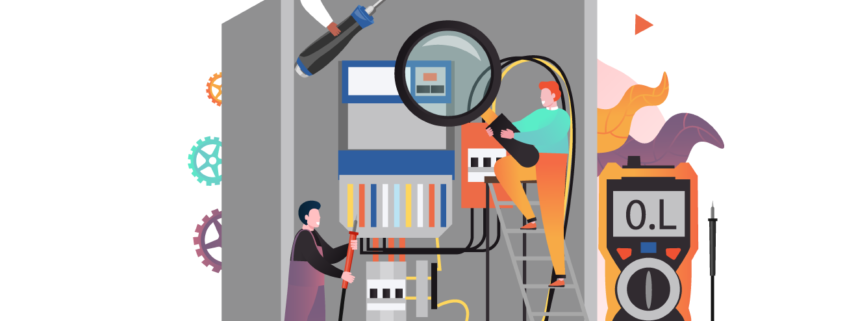Our language is continually changing to encompass new ideas and express our evolving perspectives. Sometimes this happens organically and, other times, by deliberate changes we make when we become aware that our habitual language is not in line with our respectful intentions.
Almost all of us want to show respect for the people with whom we live and work. Staying in touch with the latest ADA guidelines and recommendations for disability language is a great way to stay up-to-date in your signage, social media, and written communications. These tips may also help you feel more comfortable speaking with everyone you encounter.
Let’s explore why the words we choose matter so much, the idea of “person-first” language, some basic disability etiquette, and conversational strategies that will help you feel more comfortable and confident that your language is communicating the respect you intend.
The Power of the Words We Choose
In the past, the language surrounding people with disabilities often defined or pre-judged the individual by the nature of their condition. The problem is widespread, impacting the one in five Americans who have a disability.1 Language that is biased toward these people perpetuates old and negative stereotypes about these individuals.
When we define people by who they are and what they accomplish, rather than the physical or mental situations they face, we empower them to contribute and enrich our communities and our culture. Our socially aware and inclusive language should value people as parents, neighbors, coworkers, teachers, and friends.
Language Can Be an Obstacle
One negative example is the word “handicapped.” This word is no longer considered a respectful term to apply to a person. A handicap is an obstacle that blocks, limits, or restrains a person, and the word should not be used as an identifier for a person or group. A disability, on the other hand, is a condition a person may have that is caused by trauma, genetics, or disease.
So, instead of saying “Roberta is a handicapped artist,” we would say “Roberta is an artist who has a disability.” Or we could simply say “Roberta is an artist” in any case where Roberta’s disability is not relevant to the topic at hand.
There is even an untrue story about the origin of the term “handicapped” that links it to being a person who holds out their cap for charity. So, while official documentation and signage are slowly being updated, removing this word from your business and personal vocabulary may be a good first step in deliberately changing your language.
What Is “People-First” Language?

Most of us have experienced demeaning language at one time or another. Labeling someone based on outward appearance or unique physical attributes is known to be hurtful and bullying, and we can empathize with others who face this kind of biased and limiting language on a daily basis.
People are individuals and deserve to be mentioned before or instead of their possible disabilities. Using disability language that puts the people first, then mentioning their disabilities when appropriate, is the preferred and recommended language according to ADA guidelines and documents.2
Some examples of person-first language include saying:
- “A child with autism” instead of “an autistic child”
- “A person who is blind” rather than “a blind person”
- “A teenager with a learning disability” in contrast to “a special-needs student”
- “A person who is disabled or uses a wheelchair” instead of “a handicapped person”
- “Customers with limited mobility” versus “disabled customers”
Another way to put the person first is to ask for their preferred terms and listen to their personal preferences regarding how they refer to themselves or want to be addressed. Every person’s past history and current perspective is unique, and which phrases are perceived as respectful and inclusive language varies accordingly.
Words and Phrases that May Be Offensive
Disability language and habits that may be offensive to some individuals:
- Focusing on or mentioning the disability when it is not relevant to the topic or the situation.
- Discussing or raising the expectation that all people with disabilities must be heroic, brave, or inspiring.
- Using dramatic words to describe disabilities, including phrases like “suffers from,” “afflicted with,” “confined to,” “crippled by,” or “victim of.”
- Lumping together groups defined only by a disability; for example, “the deaf” or “the autistic.”
- The use of made-up or possibly patronizing phrases such as “differently abled” or “physically inconvenienced.”
So, What Is the Right Thing to Say to a Person with a Disability?
Talk to people who have disabilities as an active listener and with respect, which is also good advice for most conversations. There is no reason to twist and contort your language or avoid common phrases like “Did you see” or “Did you hear” or “Let’s run to the store” in the company of these individuals. Disability etiquette is about valuing people for who they are, rather than focusing on the conditions they have.
What is helpful when speaking to people with low vision, blindness, or difficulty hearing is to change your language to replace the visual or auditory clues they may miss. For example, to a person with blindness, instead of saying “The door is right over there,” say “It is the second door on your right, as you continue down the hall.”
Unfortunately, when we are unsure how to speak to someone without offending them, there is a tendency to avoid contact. This is the opposite of the intention. An essential part of good communication is not fearing a well-intentioned mistake. All participants in a conversation have a responsibility to help each other connect. Choose words that you feel comfortable with and be open to honest feedback from those with whom you speak. These tips are equally helpful in almost all social encounters.
Respecting the Needs of People with Disabilities

There are some other situations where you might wonder about the etiquette of offering assistance or engaging with people who have limited mobility or a disability. Your good intentions can be more clearly understood when you:3
- Offer assistance, wait for a response, and follow requests or instructions from the other person. Avoid physically assisting them without their agreement, and follow their specific instructions when doing so.
- If someone’s speaking voice is difficult for you to understand, resist the temptation to pretend that you do. Instead, ask them to repeat themselves or to write down the words you do not understand.
- Schedule events and meetings with the needs of all attendees in mind. Make sure the event area is accessible and that there are adequate breaks scheduled and accessible restrooms. Provide interpreters as needed, and offer information in both visual and audio formats.
- Ask about and offer accommodations for anyone and everyone who is attending your event or visiting your business and home, regardless of whether they have a visually discernible disability or not. By doing so, you make it easy for people to ask for what they need to be safe and comfortable.
- Remember that mobility devices such as wheelchairs are part of someone’s personal space. Avoid grabbing a wheelchair without asking, leaning on it, or otherwise infringing on a person’s freedom of movement without asking.
- Service animals are highly trained to focus on their work. Avoid distracting them and do not speak to the animals, offer them food, or pet them without the person’s permission.
- Address people directly and at eye level when possible. Even if they have a caregiver or interpreter, make eye contact and speak to them personally. Sitting or crouching to speak to a person who uses a wheelchair will help prevent neck strain and make it easier to see eye to eye.
Making Yourself More Accessible
Making these kinds of intentional changes in how you communicate and engage with people who have disabilities is a benefit for you as well. You literally become more accessible and easier to talk to, work with, and get to know. You will meet people with unique perspectives and truly engage them as neighbors, friends, and regular customers.
Learning more about inclusive language and the ADA guidelines for both physical accessibility and creating a welcoming environment for those with disabilities is a personally rewarding action that also makes the lives of those around you better. At ADA Solutions, Inc., we are committed to helping individuals, nonprofits, and businesses become fully accessible and fully engaged in our communities. Contact us today to learn more about this topic and how to evaluate your home, business, or facility for ADA-accessibility improvements.
Sources:
- https://tcdd.texas.gov/resources/people-first-language/
- https://adata.org/factsheet/ADANN-writing
- http://nwadacenter.org/factsheet/respectful-interactions-disability-language-and-etiquette








